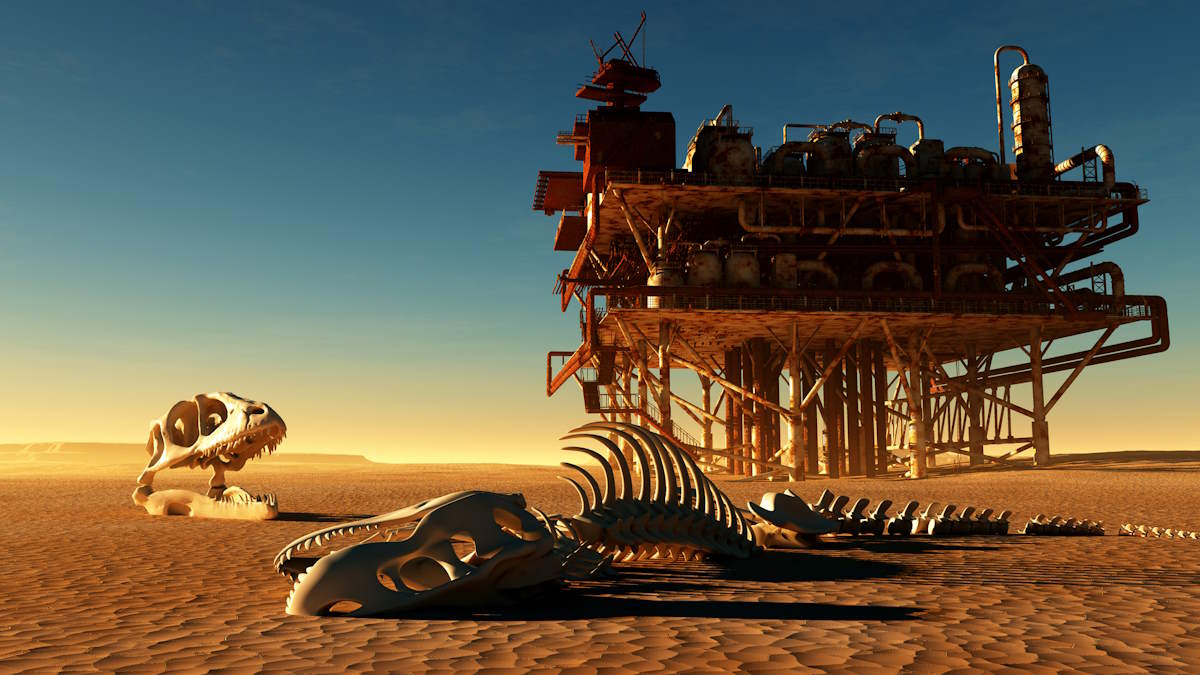For generations, a popular myth has been fossilized in our collective consciousness: that oil, our critical energy resource, comes from dinosaurs. This age-old notion, often reinforced by popular culture, has turned out to be just that – a myth. As fascinating as the idea of fueling our cars with remnants of T-Rex or Triceratops may seem, the true origin story of oil is vastly different and goes back even further in Earth’s history. Let’s delve into this intriguing tale of geological transformation.
The real origin of petroleum [crude oil]
Crude oil is formed from the remains of small aquatic plants and animals (such as algae and zooplankton) that lived and died in ancient seas between 10 million and 600 million years ago. Over many centuries, these organic remains got mixed with layers of silt. As more and more sediment was deposited over them, the heat and pressure increased on the lower layers. This process caused the organic material to change, first into a waxy substance called kerogen, which is found in oil shales, and then, with more heat and pressure, into liquid and gaseous hydrocarbons in a process known as catagenesis.
Typically, oil formation happens in conditions with temperatures between 60-120 degrees Celsius, within what geologists and petroleum engineers call the “oil window.” The precise time it takes for oil to form depends on the specific environmental conditions. However, it’s estimated to be on the order of hundreds of thousands to millions of years.
In terms of geologic time, most of the oil that we extract today was formed during two periods: the Jurassic period (from 200 to 145 million years ago) and the Cretaceous period (from 145 to 66 million years ago). However, oil formation spans a larger range, and oil can form from organic matter deposited in much earlier geologic periods, dating as far back as the Cambrian period, over 500 million years ago. Therefore, the assertion that petroleum comes from the remains of dinosaurs (which lived between 230 and 65 million years ago) is not entirely accurate, as most oil predates the dinosaurs.
The oil we have today has been trapped in the rock layers and over time, moved or migrated due to the intense pressure and heat of the Earth’s crust to places where we can access it. The conventional method of oil extraction involves drilling a well into a geological formation, allowing oil to flow up the well where it’s then collected.

So, why do people think the oil comes from dinosaurs?
As explained above, contrary to popular belief, the creation of crude oil is not linked to the bodies of dinosaurs. In fact, this myth is largely attributable to a marketing campaign by the Sinclair Oil Corporation in the 1930s. This prevalent misconception is so deeply embedded in the public psyche that even the idea of fossil fuels being derived from fossils, and by extension from dinosaurs, has gained traction.
In reality, the formation of oil is a process dating back hundreds of millions of years and involves microscopic ocean-dwelling plants and animals known as algae and zooplankton. When these organisms die, they fall to the ocean floor and accumulate in thick layers. Over time, these deposits get covered by layers of silt, which eventually solidify into sedimentary rocks such as shale under the immense pressure of the rock layers. Over millions of years, these remains have transformed into petroleum.

Related: Largest Dinosaurs
Founded in 1916 by the American industrialist Harry F Sinclair (July 6, 1876 – November 10, 1956), Sinclair Oil became the seventh-largest oil company in the U.S. and the largest in the American Midwest. The company’s association with dinosaurs began in 1930 with an advertising campaign that featured illustrations of 12 different dinosaurs on a series of oil cans. Sinclair’s green brontosaurus logo, registered as a company trademark in 1932, became a common sight at hundreds of Sinclair service stations across the country.
Sinclair’s marketing strategy aimed to convince customers that better oil came from older deposits. The public, however, took this association literally, leading to the widespread belief that oil originated from dinosaurs. This notion was further cemented when Sinclair sponsored a dinosaur-themed exhibit at the 1933-1934 Century of Progress World’s Fair in Chicago, an event that attracted a vast number of visitors.

The myth surrounding oil’s origins persisted and became increasingly popular over the years, further encouraged by Sinclair’s ongoing association with dinosaurs. The company’s dinosaur-themed merchandise, dinosaur mascot, and sponsorship of various dinosaur-themed events and exhibits across the United States all contributed to the enduring belief in the link between dinosaurs and oil.
Over time, more information about the prehistoric world has emerged. We now know, for instance, the majority of petroleum deposits predate the age of the dinosaurs, thus invalidating the association Sinclair was trying to make in its exhibits and advertisements.
Despite this, the myth that oil comes from dinosaurs, a notion deeply rooted in our collective consciousness thanks to a nearly century-old marketing campaign, is likely to persist for years to come.
As we move towards more sustainable energy sources, the hope is that the use of fossil fuels will eventually become obsolete, just like the dinosaurs themselves.

Sources
- Petroleum on Wikipedia
- Sinclair Oil Corporation on Wikipedia
- Moon Landings: All-Time List [1966-2025] - February 2, 2025
- What Is Max-Q and Why Is It Important During Rocket Launches? - January 16, 2025
- Top 10 Tallest Rockets Ever Launched [2025 Update] - January 16, 2025
